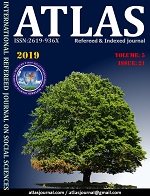ANALYSIS OF HUMAN LANDSCAPES FROM MY COUNTRY IN THE LIGHT OF CARNAVAL AND CHRONOTOPE CONCEPTS
DOI:
https://doi.org/10.31568/atlas.343Keywords:
Nazım Hikmet Ran, Human Landscapes from my Country, translation, Mikhail BakthinAbstract
Nazım Hikmet Ran (1902-1963) is undoubtfully a unique author in the world of Turkish literature. He pioneered the change of form in Turkish poetry by combining modern poetry techniques and free verse with the traditional formats. The good example of Nazim’s unprecedented style is the work Memleketimden İnsan Manzaraları, being the topic of this study. The book, written over many years and published in Turkey only in 1960s, is composed alongside unknown patterns regarding both the content and the form. As to the content, it is richer than any of the Turkish texts created before with over 300 characters appearing in the course of action and without a single protagonist. The form of Memleketimden İnsan Manzaraları encompasses elements known from different genres: poetry, novel, scenario, play, and epic, yet, it is none of them. Thanks to its diverse structure, the text reminds the concept of a carnival, proposed by the Russian philologist and philosopher Mikhail Mikhailovich Bakhtin. Along with the idea of carnival, which stands in opposition to the so-called monopholic compositions and defends diversity, the sounds of another concept proposed by M. Bakthin - chronotope, echo among the pages. Likewise, the present study will deal with the Hikmet’s work in the light of these two concepts with appropriate examples given for consideration. Following the Turkish text, its English translation will be examined with the focus on how the concepts of carnival and chronotope were interpreted. The mentioned translation is the most extensive one: Human Landscapes from my Country, by Randy Blasing and Mutlu Konuk, published in 2002. All findings will be additionally explained by the descriptive method.
Downloads
Published
How to Cite
Issue
Section
License

This work is licensed under a Creative Commons Attribution-NonCommercial 4.0 International License.


